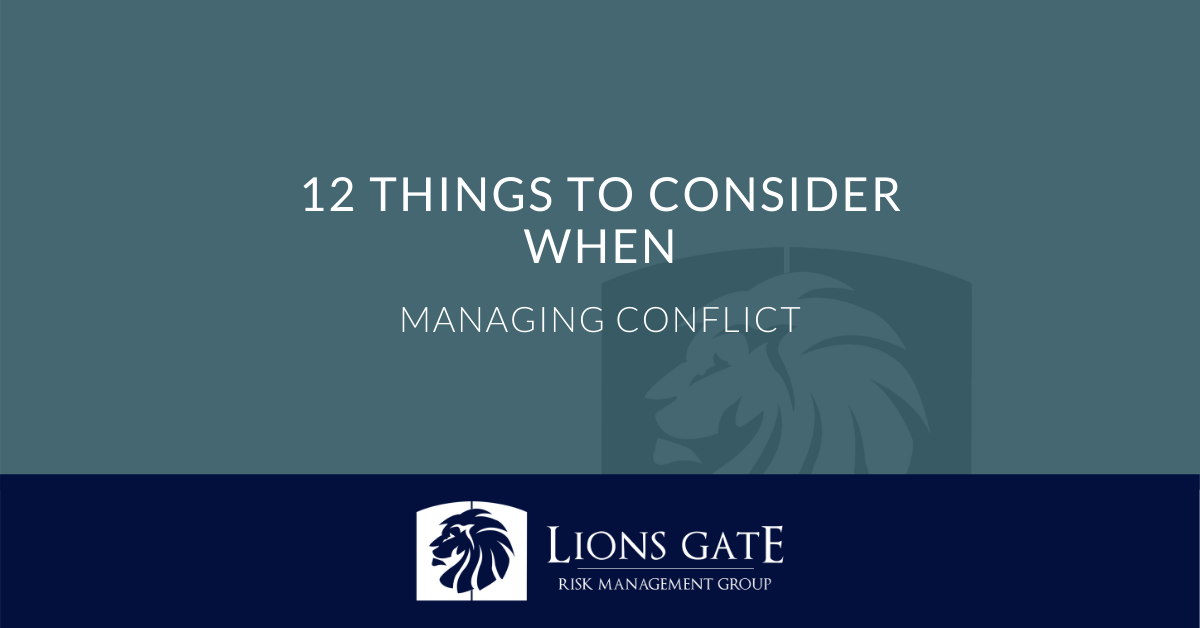3/12/2020
12 Things to Consider When Managing Conflict

Since earlier this year, COVID-19 has been driving an elevation of conflict in areas both inside and outside the home. Seasonal Affective Disorder and a deterioration in the weather is also increasing stressors and in consequence, conflicts, and the potential for conflicts.
In this article, we’ll focus on defining applications for any scenario where conflict, ranging from verbal to physical, could arise. It will be an individual rather than a prescriptive analysis, looking at both personal or stranger interactions. We’re choosing to steer clear of the politics of COVID-19, as we want to focus on providing you with some focus on understanding the management of conflict and your role in it.
In January 2021, Lions Gate will be sharing its conflict management tutorial: a free 30-minute foundation course for business organizations.
In advance of that, here are twelve important and thought-provoking considerations:
- In any conflict, you have two choices, so long as you are agile enough to recognize the onset of conflict at an early point. Through your response, you can either escalate the potential for violence or de-escalate that potential.
- Verbal de-escalation is an intervention for use with people who are at risk for aggression.
- The first and only de-escalation objective is to reduce the level of anxiety to encourage the possibility for discussion because reasoning with an enraged person is not possible.
- There are five conflict management styles: controlling or competing, compromising, avoiding, accommodating, and collaborating. Look at these closely and reflect on your style or combination of styles.
- You are already programmed with a response to conflict, a response embedded during your childhood. Unless you manage that ingrained response, it functions automatically, and is your default setting. It takes a conscious application to control this and adjust, selecting the right conflict management styles to achieve the desired outcome.
- Crisis thinking is often characterized by illogical, concrete, and unfocused responses where non-crisis thinking is more logical, abstract, and reasonable.
- Body language makes up 55% of communication, so already you are sending strong messages before even opening your mouth.
- Without specialized training, never consider the use of physical force as your first response.
- Place your hands in front of your body in an open and relaxed position. Be at the same eye level whenever possible in any engagement, and don’t look to adopt a superior position.
- If your attempt at de-escalation is not working quickly STOP. If the situation feels unsafe, LEAVE, and CALL FOR HELP.
- Be respectful when firmly setting limits or calling for help. The agitated individual is very sensitive to feeling shamed and disrespected.
- Remember the acronym TACOS for de-escalation DON’T’s: don’t threaten, don’t argue, don’t challenge, don’t order, and don’t shame.
Contact michaelfranklin@lgrmg.ca to schedule a webinar slot for your organization in January and join our interactive and insightful foray into the management of conflict including liabilities and exposures. For any support and assistance call 1.604.383.0020 or toll-free at 1.800.212.2026 or visit www.lgrmg.ca at any time. Our expertise is your peace of mind.
